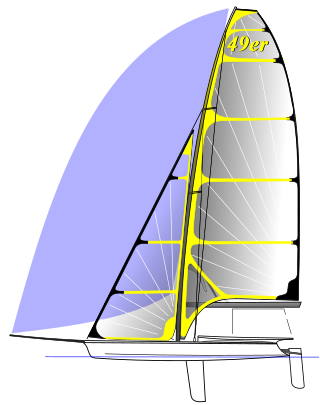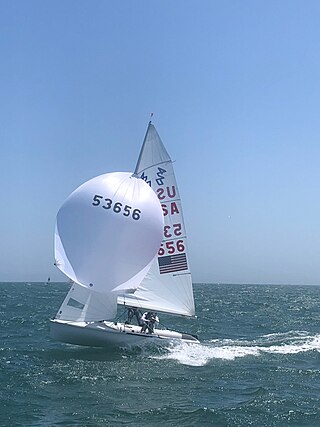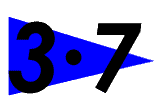
Dinghy sailing is the activity of sailing small boats by using five essential controls:

The 49er and 49er FX is a two-handed skiff-type high-performance sailing dinghy. The two crew work on different roles with the helm making many tactical decisions, as well as steering, and the crew doing most of the sail control. Both of the crew are equipped with their own trapeze and sailing is done while cantilevered over the water to the fullest extent to balance against the sails.

The International 420 Dinghy is a sailing dinghy popular for racing and teaching. The hull is fiberglass with internal buoyancy tanks. The 420 has a bermuda rig, spinnaker and trapeze. It has a large sail-area-to-weight ratio, and is designed to plane easily. The 420 is an International class recognised by World Sailing. The name refers to the boat's length of 420 centimetres.

The International 505 is a One-Design high-performance two-person monohull planing sailing dinghy, with spinnaker, utilising a trapeze for the crew.

The Fireball is a British sailing dinghy that was designed by Peter Milne as a one-design racer and first built in 1962.

The 18 ft Skiff is considered the fastest class of sailing skiffs. The class has a long history beginning with races on Sydney Harbour, Australia in 1892 and later in New Zealand. The boat has changed significantly since the early days, bringing in new technology as it became available. Because of the need of strength, agility and skill, the class is considered to be the top level of small boat sailing. Worldwide this boat is called the "18 Foot Skiff". It is the fastest conventional non-foiling monohull on the yardstick rating, with a score of 675, coming only third after the Tornado and Inter 20.

The Flying Eleven is an Australian boat designed as a high performance racing skiff suitable for 12- to 18-year-olds. High performance sailing is fast becoming the goal of a great many dinghy sailors with the appearance of 49ers as an Olympic class.The Flying Eleven is a logical step in the transition between junior classes such as the Manly Junior or Sabot and prepares young sailors for classes such as Cherubs, 420s, 470s, 29ers, Moths, 13s or even 49ers.

The International 14 is a British racing sailboat, crewed by two sailors. The class was established in 1928.

The 12 ft Skiff is a development dinghy class dating back to the early 20th century. It is sailed in Australia and New Zealand. It is 12 ft (3.7 m) in length, hence the name, and is a two-man boat. Both the crew and the helm are able to use the trapeze at the same time. It has an asymmetrical spinnaker and a jib, in addition to the mainsail.
Idle-Along (IA) - is a class of sailing dinghy designed by Alf (Unc) Harvey at Petone in 1927. It grew to considerable popularity in the 1950s but its popularity gradually diminished during the 1960s. A redesigned hull for plywood construction by John Spencer kept the class going but on a smaller scale with a small revival in the 1990s with about 10 new boats being built. The Idle-Along is also sometimes referred to as IdleAlong, Idle Along, IA, I Class and Idie.

The Laser 3000 is a racing sailing dinghy crewed by two persons with a trapeze for the crew. Launched in 1996, the 3000 was developed from the Laser 2, using the original Frank Bethwaite-designed planing hull combined with a brand new self-draining deck by Derek Clark. Clark also re-designed the rig, using spars and sails from premium proprietary sources and replacing the symmetric spinnaker of the Laser 2 by a larger asymmetrical spinnaker. The gennaker is chute-launched and retrieved using a single halyard line, and is set on a retractable bowsprit. Helm balance and handling were improved using a shorter-footed mainsail with two full-width battens giving a larger roach. A mast with conventional spreaders replaced the now-unusual diamond arrangement of the Laser 2.

The Jacksnipe is a two-man racing sailing dinghy with a single trapeze for the crew and symmetrical spinnaker.
The Pelican is a pram dinghy, peculiar to Perth, Western Australia
The Norfolk Punt is a type of yacht, derived from the flat-bottomed gun punts that roamed the Broadland waters in the mid-to-late 19th century. However, at the turn of the 20th century, in order to get to and from the hunting grounds more quickly, the punters developed their highly unstable craft to carry a basic mast and sail for travelling with the wind. It is from these humble beginnings that one of the country's most exciting and powerful racing dinghy classes was born.

The NS14 is an Australian restricted development class of sailing dinghy. Measuring 14 feet in length, the class was designed the 1960 and introduced at the Northbridge sailing club in Sydney, Australia, with control of the class transferred to the NS14 Association of New South Wales in 1965. Subsequently the boat was introduced to the other states, prior to being taken to New Zealand in 1995 and the United States in 1998.

The 125 is a 12 ft 6 in (3.81 m) two person intermediate sailing dinghy complete with main, jib, spinnaker and trapeze. The 125 class has a strong following within Australia with national titles being held every year around the country and local state associations. The class was originally designed as an intermediate class for developing skills with the jib, spinnaker and trapeze but has become popular from novice to experienced sailors.

The Javelin is a high-performance skiff type dinghy sailed in Australia and New Zealand. The class was founded by designer John Spencer in 1961. Spencer also founded the Cherub Class. It is 14 feet long, sporting a large sail area, single trapeze and asymmetrical spinnaker. The Javelin is a development class, meaning that boats vary in shape within a framework of rules, rather than being all built to the same design. Bruce Farr is another well-known designer who drew successful Javelins.

The Farr 3.7 is a one-person sailing dinghy designed by Bruce Farr in 1971. The design plans are sold by the 3.7 Class Owners Association and they are built by a mix of professionals and home built by amateurs. The 3.7 Class is recognised by Yachting New Zealand as a national class and yachts are sailed in New Zealand, Australia and Great Britain. Full sets of plans have been sold worldwide to a number of individuals with greatest numbers in Germany, Japan, USA, South Korea, Poland, France, Belgium, Russia, Spain, Uruguay.
The Skate is a high performance two-person racing dinghy unique to Australia. Designed as a monohull sailboat it's fourteen feet long (4.27m) with a 7.2m mast, 1.8m bow pole and masthead asymmetrical spinnaker. It is an Australian national class.
Julian Bethwaite is an Australian, Sydney-based skiff sailor and sailboat designer. He wrote one chapter of his father Frank's book, Higher Performance Sailing.



















